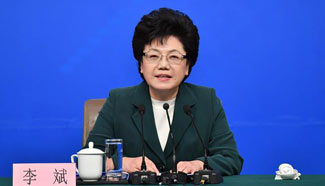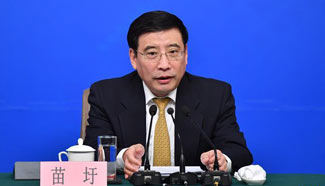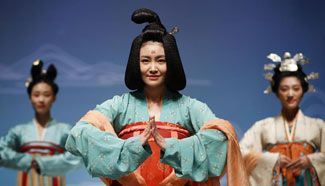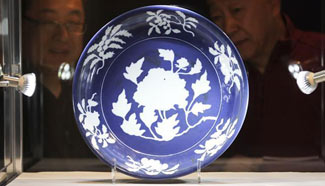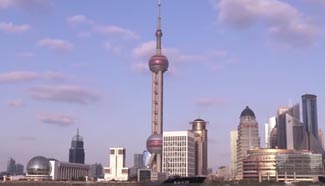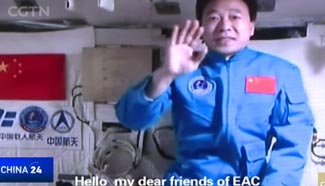BEIJING, March 11 (Xinhua) -- No photos are allowed in the exhibition, so Ou Xiaoyang took out her sketchbook and drew the shadow puppet on display.
It was Saraba, a character from the ancient Indian epic, the Ramayana. In the poem, Saraba aids a prince in his attempt to rescue his wife from a demon king.
The puppet was made on the Indonesian island of Java in the early 19th century.
"I never knew that Indonesia made such beautiful shadow puppets," said Ou, a senior student at Beijing Forestry University.
"I am impressed by the brilliance of many civilizations. They each have their own colors and shapes. But they are interconnected because they all represent humanity's pursuit of beauty," she continued.
The puppet is one of the items which comprise "A History of the World in 100 Objects," a travelling exhibition tour curated by the British Museum, which arrived at the National Museum of China in Beijing on March 1.
This exhibition showcases 100 objects from the British Museum's collection of more than eight million items.
STORIES OF THE WORLD
The selected objects are as diverse as the exhibition's title implies, ranging widely in age and origin: from a 1.8-2 million year-old stone chopping tool from Tanzania's Olduvai Valley, to a 3,000 year-old statue of Egyptian pharaoh Ramesses II, to a plastic solar-powered lamp created in China just seven years ago.
The exhibition was inspired by a 100-part radio series made by the British Museum and BBC in 2010. The program was a hit in Britain, achieving 1.1 million listeners at its peak.
In 2011, the British Museum published A History of the World in 100 Objects through Penguin Books, and in 2014 the namesake touring exhibition began in Abu Dhabi.
Thus far the exhibition has visited the United Arab Emirates, Japan and Australia, and the British Museum now invites Chinese audiences to explore this special presentation on the history of the world.
DIALOGUES BETWEEN CIVILIZATIONS
The 100 objects come from five different continents, and span two million years. Together, they create a colorful image of the world.
"Cultures from all around the globe should be represented and be able to be viewed side by side," said Belinda Crerar, exhibition curator from the British Museum.
"We hoped to illustrate how similar concerns and desires have motivated the development of human societies in all parts of the world and are reflected in the objects that they have made," she told Xinhua.
"The exhibition, with this unique approach to history, leads the audiences through the world's close cultural ties and makes them understand the importance of dialogues and mutual respect between civilizations." said Lyu Zhangshen, director of the National Museum of China.
Lyu added that the equality and balance between different civilizations offered wisdom and strength, and will ultimately contribute to global harmony and prosperity.
The National Museum of China added a 101st object to the exhibition -- the wooden hammer and pen used during China's accession to the WTO in 2001.
The final object was selected in collaboration with the host venue, said Crerar. "It allows the exhibition to end with an object that resonates personally with the local audience."
A MAJOR COLLABORATION
In 2012 and 2013, the National Museum of China hosted a porcelain exhibition with the British Museum and the Victoria and Albert Museum.
In September 2015, before the China-UK Economic and Financial Dialogue in Beijing, George Osborne, then British Chancellor of the Exchequer, announced that A History of the World in 100 Objects would be coming to the Chinese mainland, marking the beginning of a new collaboration.
"We have been preparing for this exhibition since then," Yan Zhi, the exhibition curator of the Chinese side, told Xinhua. "This is among those that have taken the longest for the museum to prepare."
Yan said that he was impressed by the professionalism, seriousness and meticulousness of his British colleagues.
"We handle every item with extreme caution," said Karen Birkholzer, senior conservator at the British Museum.
She cited six Lewis chessmen on display, discovered on the Isle of Lewis of Scotland in 1831. The delicate chessmen, fashioned out of walrus ivory during the 12th century, need stable humidity and temperature, requiring the staff to be quick to put them into the gallery case.
"It was a huge pleasure to visit Beijing and to receive such a warm welcome at the National Museum of China. Working with the team there has been a great experience," said Crerar.
She added that it was a real privilege to view the collections in the National Museum of China detailing China's long and rich history.
CULTURAL EXCHANGE
Barbara Woodward, British Ambassador to China, said that the exhibition is an excellent example of positive cultural exchange between China and Britain.
"We have reached a golden era in our global relations," said Woodward.
She paralleled the strong UK-China relationship with a three-legged Chinese Ding (an ancient Chinese bronze vessel): "We have a strong government-to-government relationship; we have a strong economic and business relationship; and we have a relationship that fosters beneficial cultural exchange."
"It's wonderful to see the objects, and it's wonderful to have a chance to think about history: the past, present and future," she told Xinhua.
Woodward also said the Chinese objects in the exhibition "celebrate China's role in global history."
This trip was Birkholzer's first time in Beijing. She expressed her fondness of Chinese civilization, and managed to find time in her busy schedule to visit the Temple of Heaven and the Palace Museum.
"Every culture has something special," she said, adding that she is delighted that audiences around the world have the opportunity to experience the diversity of the world's civilizations.
"The development and innovations of the world's civilizations are grounded on shared aspirations. We have all encountered similar opportunities and similar challenges," said Long Feifei, a sophomore at the Communication University of China.
"No civilization is superior to another and different civilizations should learn from each other and seek the road to common development," she said.
Zhang Ying, an educator and mother of two, brought her sons -- two and nine years old -- to the exhibition.
"I want to impart the importance of history to my children," she said. "Knowledge of history makes a person wise."
"I don't expect them to understand everything at this age. But if they remember traces of the exhibition, it may change their future understanding of the world."

